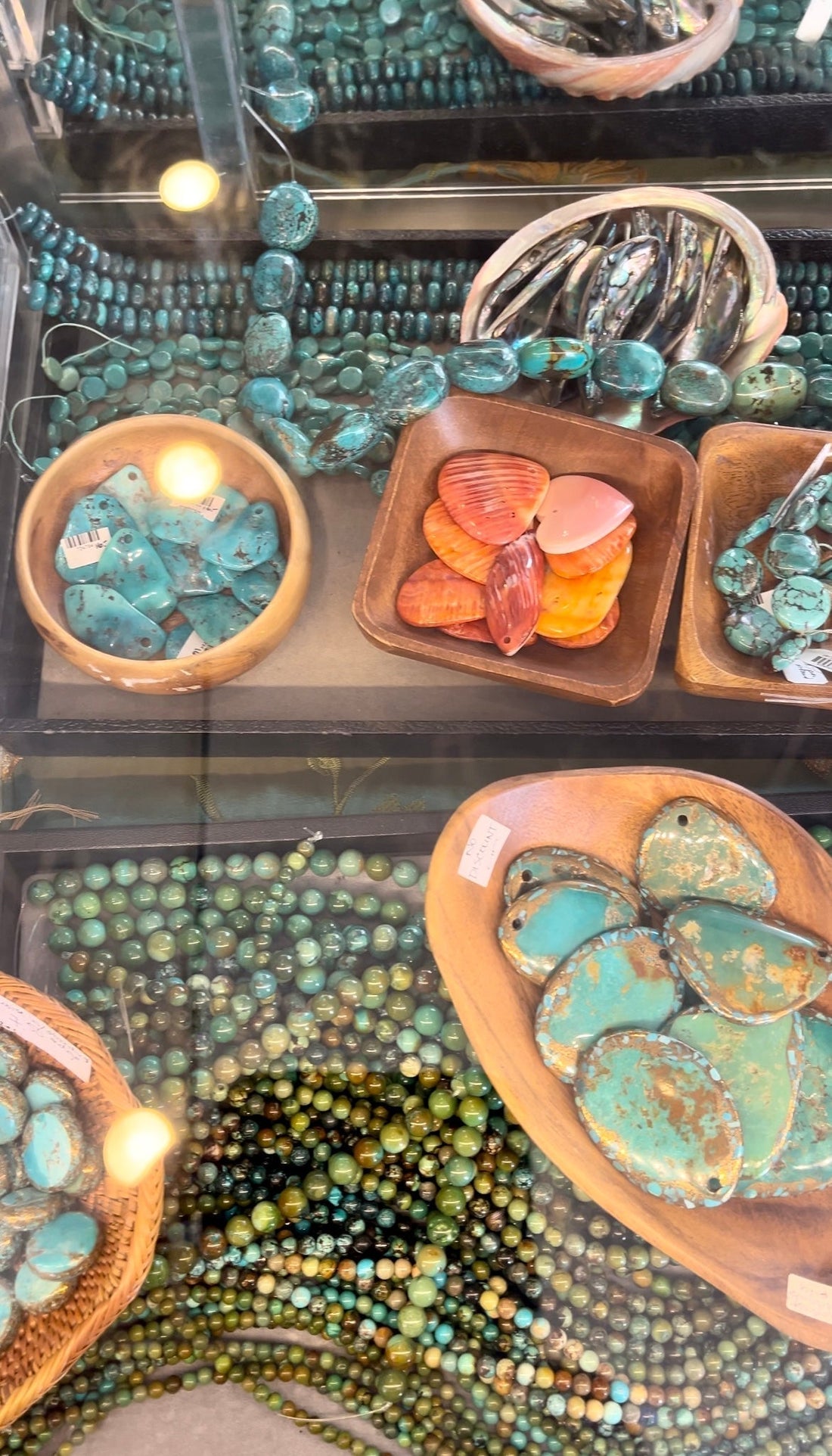
Turquoise: The Sponge of Negativity
Share
Turquoise is a hydrated phosphate of aluminum and copper, formed when water seeps into rocks rich in phosphorus, aluminum, and copper. It typically develops near copper deposits. Most turquoise mines are located in desert regions such as the Southwestern United States, Iran, China, and Afghanistan.
The documented history of turquoise dates back to 4000 BC, with deposits found in northeastern Persia, where high-quality turquoise adorned the tombs of Persian nobles. The oldest and most famous Egyptian mine dates to 3000 BC, located in the Sinai Peninsula at Serabit el-Khadim, supplying pharaohs and nobility with gemstones for jewelry and artifacts. Since the dawn of Egyptian archaeology, turquoise has been discovered in almost every significant royal burial.
The word "turquoise" comes from the French pierre turquoise, meaning "stone from Turkey". In the 17th century, French traders found large quantities of turquoise in the bazaars of Istanbul, Ankara, and Izmir, mistakenly believing it originated in Turkey. It was later discovered that the true source was Persia.

Until the early 20th century, over 40 mines produced turquoise in the American Southwest, including Arizona, New Mexico, Nevada, and Colorado. Today, only the Kingman mine in Arizona remains in full operation. In September 2012, the Sleeping Beauty mine unexpectedly closed after being fully depleted. Some speculate that digging another 1,000 feet deeper may reveal more, but the cost is prohibitive. In 1960, the legendary #8 Spiderweb Turquoise mine in Nevada ceased production. This mine was highly prized by Native Americans for its intricate spiderweb matrix, making it one of the most sought-after types of turquoise.
Curiously, while Europeans and East Coast Americans favor pure robin’s egg blue Persian turquoise, Tibetans and Native Americans prefer stones with pronounced matrix patterns.
Turquoise Stabilization and Treatment

Nearly all turquoise available on the market today has undergone stabilization to enhance its durability. Naturally, turquoise is soft, sometimes brittle, and porous, leading to significant material loss during carving. Some of this waste is mixed with resins to create fake turquoise. To minimize loss, raw turquoise is treated with a hardening solution, often through a pressurized impregnation process, which forces the stabilizing agent deep into the stone.
Although high-quality natural turquoise is rare and valuable, stabilization has become standard practice to protect the stone from dirt and fractures. Even top-grade turquoise is often stabilized to prevent deterioration over time. However, dyed turquoise should be avoided, as low-quality stones are often artificially colored during stabilization to mimic a higher grade of turquoise.
Turquoise in Native American Culture
Among Native American tribes, turquoise was historically found only within a region stretching from the Isthmus of Panama to an imaginary line crossing southern Nevada, Colorado, Texas, and the Gulf of Mexico. No significant prehistoric turquoise deposits have been located outside this boundary.
The abundance of turquoise beads in early Southwestern archaeological sites suggests that the Pueblo peoples did not trade with Eastern or Northern tribes. Instead, they exchanged turquoise with Mexico and California, where specimens of New Mexican turquoise have been found.

Among the Pueblo and Diné (Navajo), turquoise beads and amulets were symbols of family wealth. Any significant turquoise deposits show evidence of ancient mining, such as the famous Los Cerillos mine in New Mexico, which was extensively mined before Spanish colonization.
In 1539, the explorer Fray Marcos de Niza, accompanied by Estevan the Moor, traveled northward into present-day New Mexico in search of the legendary Seven Cities of Gold. Near the Arizona border, they encountered the Sobaipuri Indians, who adorned themselves with turquoise beads. Approaching Cibola (Zuni), they found the villagers wearing turquoise amulets called cacona, suspended from their ears and nostrils.
Upon finally reaching the Seven Cities of Gold, the setting sun cast a golden glow on the adobe buildings, creating an illusion of gold. Frenzied with excitement, the explorers rushed into the village, shouting about their discovery. However, they soon realized that for the native people, turquoise—not gold—was the true treasure, used as currency and a sacred symbol.
Turquoise in Southwest Mythology
In Native American traditions, turquoise is a sacred stone, a conduit of creative and spiritual energy. According to Pueblo legend, turquoise originates from the womb of the Earth, the place from which all life emerged.
For the Hopi, turquoise is associated with the Universal Mother, Whuring Whuti, who holds turquoise beads and shells. She is believed to have created the Male Earth Spirit and Water Woman, symbols of fertility and the cycle of life.
The Navajo tell the story of Changing Woman, the Turquoise Goddess, a divine figure born from the union of Sky and Earth. She first appeared as a small turquoise figure, growing in beauty and power. It is said that she created the Sun using turquoise beads from her right breast and the Moon using white shells from her left breast.
These myths highlight turquoise’s deep spiritual significance in Native cultures. It is not just an ornament but a bridge between Earth and Sky, the visible and the unseen, a symbol of protection, strength, and divine connection.
Turquoise is connected to the elements of Earth and Air, harmonizing masculine and feminine energies. It is a symbol of stability, balance, and peace. This stone stimulates intellect, creativity, and communication, helping to clarify thoughts and let them flow freely through the voice. It is particularly beneficial when worn as a pendant at the throat, helping to maintain composure when speaking in public. Known as a stone of truth and wisdom, turquoise strengthens individuality when placed in service of the greater good.
Turquoise fosters self-forgiveness, helping to overcome past mistakes and missed opportunities. It encourages self-acceptance and discourages self-sabotage. It teaches balance in life, aiding in the control of anger, aggression, and mood swings. This stone brings serenity and emotional stability, reducing stress and helping to focus on genuine feelings. It is a guide toward happiness and spontaneity in love, aiding in recognizing true joy and dissolving inherited false beliefs.
An ancient stone, turquoise has long been a symbol of wisdom and protection. Simply holding it in your hands provides an immediate sense of calm. It is also regarded as a powerful good luck charm, especially for travel, capable of attracting success and creativity while shielding against anything negative or harmful.
